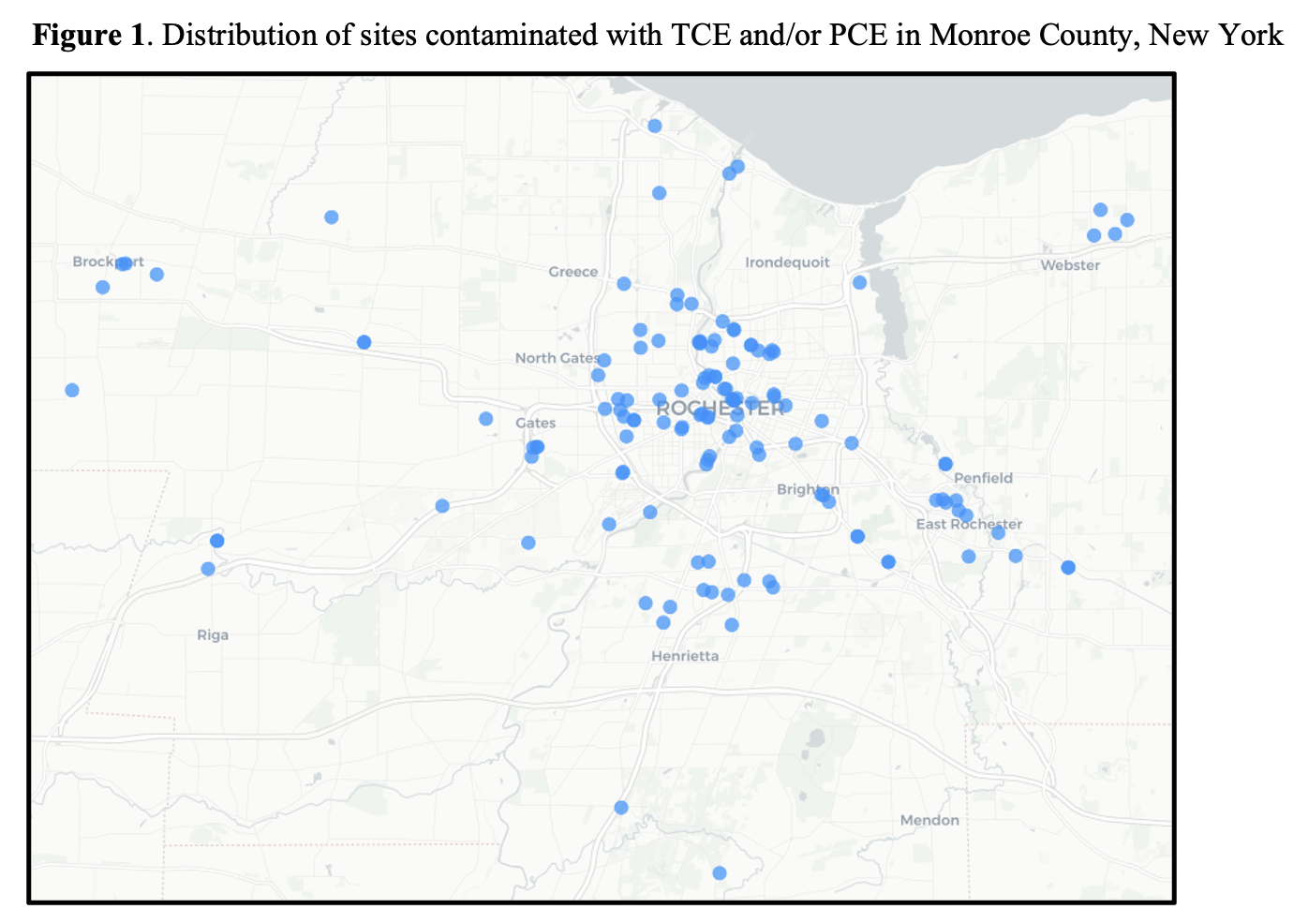Category: Epidemiology
Objective: To describe methodology used to collect data on trichloroethylene (TCE) and perchloroethylene (PCE) contamination in Monroe County, New York.
Background: TCE and PCE, chlorinated solvents commonly used in dry cleaning and degreasing, are known carcinogens and have increasingly been linked to Parkinson’s disease (PD) in animal [1] and epidemiological studies [1,2]. People who do not directly work with TCE or PCE can still be exposed through a process called vapor intrusion, where the chemical can evaporate from soil and enter buildings, like radon. However, the extent of TCE and PCE contamination can be difficult to discern due to the limited publicly available datasets related to groundwater and soil contamination. Aggregating data on TCE contamination and presence of the chemical in groundwater and soil can enable future epidemiological studies and serve as an important resource for the protection of public health.
Method: We collected information from public records in the New York State Department of Environmental Conservation (NYSDEC) Site Remediation Database. An environmental engineer reviewed documentation for sites in Monroe County in the database and collected a predefined set of 22 attributes. Attributes included: location of the site, presence of TCE, presence of PCE, approximate periods of contamination, current remediation status, groundwater and soil contamination, and presence of vapor intrusion where known. Annotations from the environmental engineer were reviewed and validated for format and consistency.
Results: 310 site codes for Monroe County in the NYSDEC database were reviewed. Of these 310, 134 unique sites were found to be contaminated with TCE and/or PCE [figure1]. In sites with TCE and/or PCE contamination, 125 (93%) had known groundwater contamination, 125 (93%) had known soil contamination, and 73 (59%) had known vapor intrusion. In 83 (61%) cases, groundwater and/or soil contamination was also discovered off-site.
Conclusion: The methodology we used successfully captured presence of TCE contamination at a high level of granularity in Monroe County, New York. In the future this framework can be extended to all of New York State. Data generated from these records will also be transformed into an interactive resource for the public, and can be used for future epidemiological work on TCE and PD in Monroe County.
Figure 1
References: [1] De Miranda, B. R., Castro, S. L., Rocha, E. M., Bodle, C. R., Johnson, K. E., & Greenamyre, J. T. (2021). The industrial solvent trichloroethylene induces LRRK2 kinase activity and dopaminergic neurodegeneration in a rat model of Parkinson’s disease. Neurobiology of disease, 153, 105312. https://doi.org/10.1016/j.nbd.2021.105312
[2] Goldman, S. M., Weaver, F. M., Stroupe, K. T., Cao, L., Gonzalez, B., Colletta, K., Brown, E. G., & Tanner, C. M. (2023). Risk of Parkinson Disease Among Service Members at Marine Corps Base Camp Lejeune. JAMA neurology, 80(7), 673–681. https://doi.org/10.1001/jamaneurol.2023.1168
[3] Dorsey, E. R., Kinel, D., Pawlik, M. E., Zafar, M., Lettenberger, S. E., Coffey, M., Auinger, P., Hylton, K. L., Shaw, C. W., Adams, J. L., Barbano, R., Braun, M. K., Schwarz, H. B., Lawrence, B. P., Kieburtz, K., Tanner, C. M., de Miranda, B. R., & Goldman, S. M. (2024). Dry-Cleaning Chemicals and a Cluster of Parkinson’s Disease and Cancer: A Retrospective Investigation. Movement disorders: official journal of the Movement Disorder Society, 10.1002/mds.29723. https://doi.org/10.1002/mds.29723
To cite this abstract in AMA style:
M. Pawlik, K. Hylton, S. Hussain, M. Piraino, D. Kinel, R. Dorsey. PREVENT-PD: A Framework for Collecting Trichloroethylene Contamination Data in New York State [abstract]. Mov Disord. 2024; 39 (suppl 1). https://www.mdsabstracts.org/abstract/prevent-pd-a-framework-for-collecting-trichloroethylene-contamination-data-in-new-york-state/. Accessed October 18, 2025.« Back to 2024 International Congress
MDS Abstracts - https://www.mdsabstracts.org/abstract/prevent-pd-a-framework-for-collecting-trichloroethylene-contamination-data-in-new-york-state/

